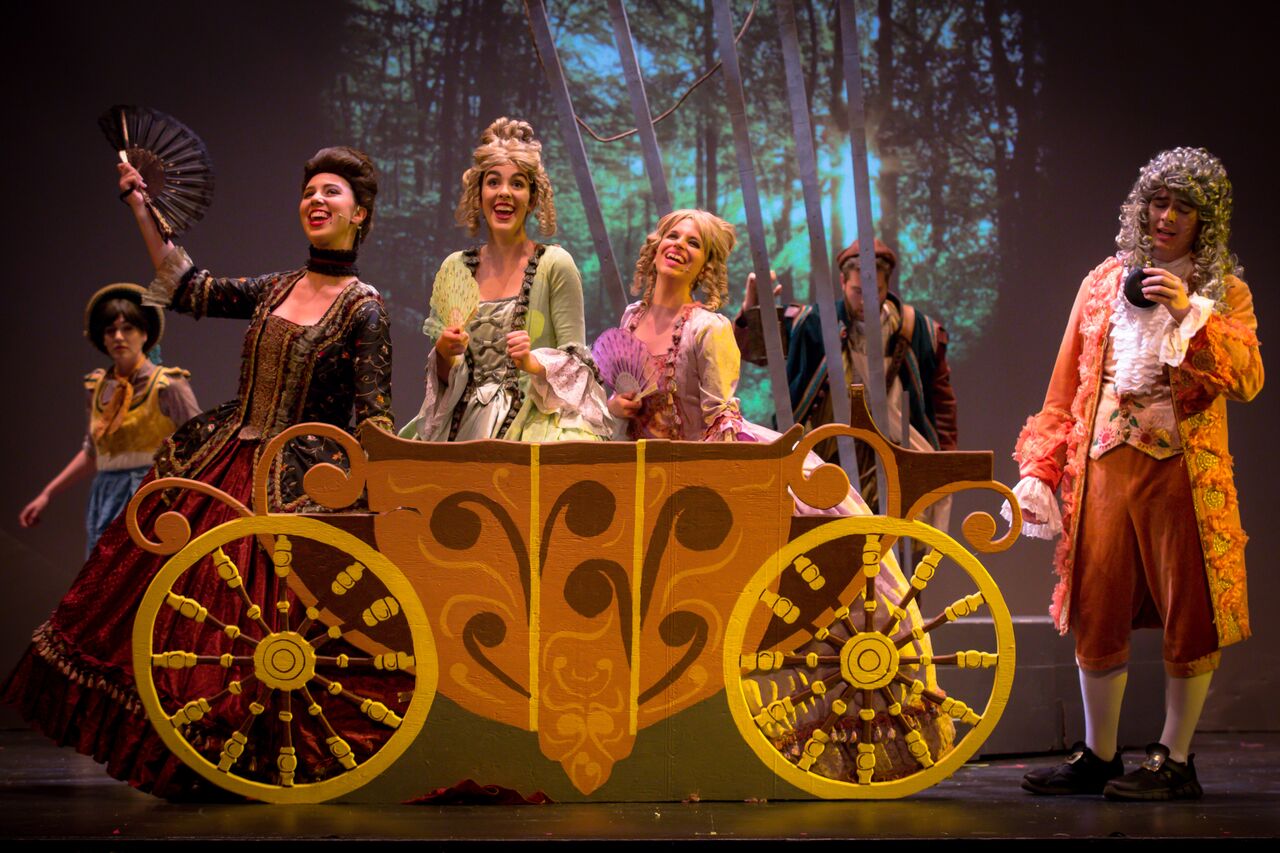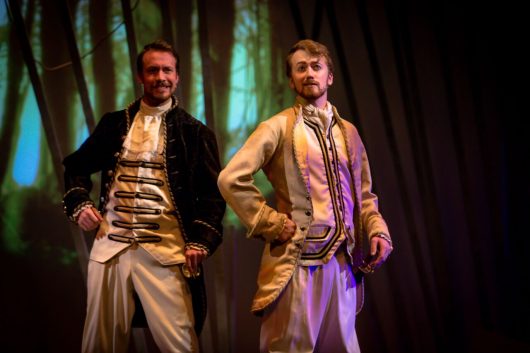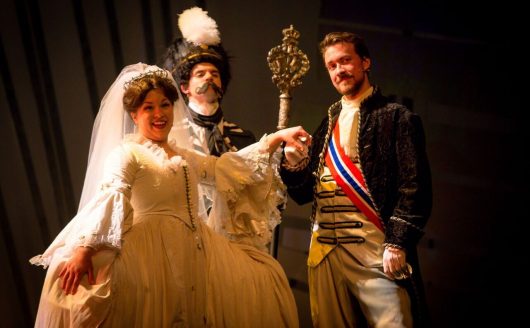Into the Woods: The end justifies the beans
Posted on June 25, 2018 By Colin MacLean Entertainment, Front Slider, Theatre
 From The Princess Bride to a little piece of cinema called Frozen, we have seen a proliferation of musicals about storybook characters – none more effective and long-lasting than Into the Woods, the 1987 Stephen Sondheim-James Lapine effort at unpacking modern moral lessons in the stories of Cinderella, Jack and the Beanstalk, Little Red Riding Hood, Rapunzel and a couple of morally-challenged good ol’ boy Princes.
From The Princess Bride to a little piece of cinema called Frozen, we have seen a proliferation of musicals about storybook characters – none more effective and long-lasting than Into the Woods, the 1987 Stephen Sondheim-James Lapine effort at unpacking modern moral lessons in the stories of Cinderella, Jack and the Beanstalk, Little Red Riding Hood, Rapunzel and a couple of morally-challenged good ol’ boy Princes.
The show is now enjoying a first-rate production at Festival Place in Sherwood Park until June 30, ending off Opera NUOVA’s month-long festival of vocally-oriented musical entertainments.
 For those who have never seen any of the stage productions, or the sumptuous Meryl Streep movie, Into the Woods lays a level of modern sensibility on the 200-year-old collected folktales of the Grimm Brothers. A childless baker (Paul Forget – wry with an appealingly light touch) and his goodly wife (Rebecca Cuddy – fresh and funny with a large supple voice), go on a bean-filled, deep-forest journey to lift a curse placed on their house by a witch (Erin Pettifor – wickedly appealing).
For those who have never seen any of the stage productions, or the sumptuous Meryl Streep movie, Into the Woods lays a level of modern sensibility on the 200-year-old collected folktales of the Grimm Brothers. A childless baker (Paul Forget – wry with an appealingly light touch) and his goodly wife (Rebecca Cuddy – fresh and funny with a large supple voice), go on a bean-filled, deep-forest journey to lift a curse placed on their house by a witch (Erin Pettifor – wickedly appealing).
In the woods they meet the familiar fairy-tale characters, all of whom seem somewhat off-kilter from the stories we remember from our youth.
The first half of the show is about achieving your heart’s desire – the second half bears the admonition, “Be careful what you wish for” as an enraged giantess stalks the forest, vowing vengeance for the death of her husband. The play begins to chop off characters like an episode of Game of Thrones. In the end, the remaining players find some degree of self-knowledge.
In their search to put a modern spin on the tales, the original creators have created some problems of their own. The musical, with its famously over-elaborate structure, convoluted ethical-moral ambiguities and inordinate length often tends to get lost in its own ambition.
Luckily, someone forgot to tell that to director Brian Deedrick and his merrie band of jongleurs. They bring an ensemble vigour and an appealing light touch to the evening – celebrating the wonderful music, respecting the book and lyrics and casting a new spell of timelessness and loopy fresh charm to long-told tales. They largely overcome the show’s problems by sheer enthusiasm and palpable talent.
Deedrick is an Edmonton native who has now turned much of the world into his own private operatic stage. With inventive brio, he makes sure that all of this is not just warmed-over Disney but a brisk, wry-filled, vaguely cynical tale told with collective enthusiasm by a well-schooled company. He fills the stage with motion, colour and character.
 You know the characters. There’s Jack (Brent Raddall) – revealing a warm singing voice but his Jack is several beans short of a full beanstalk and described by his mother as “sunny but vague.” Little Red (Brenley Palmer) is a formidably bouncy, upbeat Red Riding Hood fueling the Wolf’s unhealthy interest in underage girls dressed in red. But, look out, Mr. Wolf (John Carr Cook) – the rebellious teen later shows an unexpected and rather lethal side of her character. Cinderella’s Prince (Cook again – hilariously preening, callow and self-centred) is much too shallow a fellow for everlasting love. “I was raised to be charming but not sincere,” he says, and stops the show in Act I, with Rapunzel’s equally callow Prince (Nathan Sawatzky-Dyck – dashing but dumb), for their rueful duet, Agony – on how difficult it is to be a royal. They are so good they come back in Act II with the same song.
You know the characters. There’s Jack (Brent Raddall) – revealing a warm singing voice but his Jack is several beans short of a full beanstalk and described by his mother as “sunny but vague.” Little Red (Brenley Palmer) is a formidably bouncy, upbeat Red Riding Hood fueling the Wolf’s unhealthy interest in underage girls dressed in red. But, look out, Mr. Wolf (John Carr Cook) – the rebellious teen later shows an unexpected and rather lethal side of her character. Cinderella’s Prince (Cook again – hilariously preening, callow and self-centred) is much too shallow a fellow for everlasting love. “I was raised to be charming but not sincere,” he says, and stops the show in Act I, with Rapunzel’s equally callow Prince (Nathan Sawatzky-Dyck – dashing but dumb), for their rueful duet, Agony – on how difficult it is to be a royal. They are so good they come back in Act II with the same song.
If anyone can be called a standout in the cast of equals, it’s Cinderella (Emily Ready – spirited, with a lovely voice but not too sure about all this happily-ever-after stuff). In the last act she tellingly sums up the moral of the three hour (with intermission) gallimaufry with a heartfelt delivery of the poignant ballad, No One Is Alone. John Anderson is a dapper Narrator (and also a mysterious stranger). Hayley Stacey, as Jack’s protective mother, is a standout for both her singing and comic acting.
There is often a tendency for operatically trained singers, with all the power and overacting that only years of classic training brings, to aggrandize pop music (Three Tenors, anyone?) Not here. All the participants sing well and are completely at home with Sondheim’s complex music, which occupies a unique position with one foot in Tin Pan Alley and the other in contemporary classical music. The fact that even the smallest of roles still boasts of the biggest of voices is a testament to the bench-strength of the 21 person cast.
On opening night, all was not right in the forest. The witch’s rap-like introduction off the head was drowned out by the music, a pernicious squawking microphone almost stopped the show, Rapunzel’s careening tower came in off centre and sounded as if it was going to tear the rest of the set apart; and one of Into The Wood’s best moments was lost when the transformation of the witch from crone to babe – generally carried out live in front of the audience – was obscured by a burst of fog. But only a curmudgeon would point out the small (and easily overcome) problems in a generally smooth-running production.
Much of the credit for that smoothness must go to the dexterity of conductor Robert Ursan in the pit leading the small but mighty band. His solid mastery of Sondheim’s fiendish tempo and key changes carried on through the play.
The sets and costumes, imported from New York, were impressive and certainly contributed to the elegance of Deedrick’s production.
This is a very entertaining evening of musical theatre and to lift a quote from the show itself – “If it ends right – the end justifies the beans.”
Photos by Nanc Price













